 It is hard to know where to start when speaking about this conference, held this last weekend at the Institute for Pure and Applied Mathematics (IPAM) at UCLA, and organized by Federico Ardila, Ricardo Cortez, Tatiana Toro, and Mariel Vasquez. Maybe it’s because the snow storm on the East Coast prevented me from getting there for the first day, and once I got there I felt as if I was already in catch-up mode. Maybe I was overwhelmed by the joy, talent, and radical thinking surrounding every single interaction. But I think it was more the fact that, like with many amazing and busy conferences, I just have lots of memories that are more scenes and feelings than clear summaries of talks or a play-by-play of chronological events. So in this post, I walk you through some of the most memorable moments from the conference.
It is hard to know where to start when speaking about this conference, held this last weekend at the Institute for Pure and Applied Mathematics (IPAM) at UCLA, and organized by Federico Ardila, Ricardo Cortez, Tatiana Toro, and Mariel Vasquez. Maybe it’s because the snow storm on the East Coast prevented me from getting there for the first day, and once I got there I felt as if I was already in catch-up mode. Maybe I was overwhelmed by the joy, talent, and radical thinking surrounding every single interaction. But I think it was more the fact that, like with many amazing and busy conferences, I just have lots of memories that are more scenes and feelings than clear summaries of talks or a play-by-play of chronological events. So in this post, I walk you through some of the most memorable moments from the conference.
- The community agreement. It is starting to become more common (this is a good thing) to have some sort of inclusion or accessibility statement (these are not the same, but related), and in particular a way to establish a shared code of conduct so the experience is as fruitful as possible. Conferences like the SACNAS National Conference have been doing something like this for years, but it’s more of a set of policies than an invitation (the word “policy” itself is not very inviting.) I loved the one for LatMath, especially because it is more inclusive in its language, while still setting expectations in a clear way. Under the heading, “A welcoming experience for all”:”Latinx in Math is committed to creating a professional and welcoming environment that benefits from the diversity of experiences of all its participants. We aim to offer the same respect, opportunity and value to the contributions of every participant regardless of their mathematical experience, identities and orientations. We ask you to contribute to this positive environment, and to use extra care to ensure that your words and actions communicate respect for others. Discriminatory or harassing behavior will not be tolerated.”In particular, they also give email addresses that people can contact (in strict confidentiality) if there is something that makes them uncomfortable, unsafe, or concerned. Having this front and center sets the tone, and also signals what kind of conference we are at. I wish more conferences did this.
-
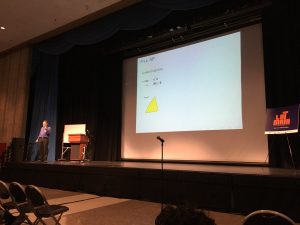
“It’s almost like a miracle… but it’s not! It’s mathematics.” Jesus De Loera.
Inspiring Latinx immigrants. Rodrigo Banuelos’s life as a series of unlikely events: from farm worker to working in a car wash where he met a mathematician who encouraged him to go to community college, then to Santa Cruz, then UCLA, and now full professor at Purdue; Edgar Lobaton and his research on biobots (cockroach cyborgs) and the ways in which we could use them for search and rescue missions in disaster areas (which by the way, raise your hand if you think this could be a good Part 3 of the Blade Runner series?); and Jesus De Loera constructing a beautiful bridge between pure and applied mathematics through integer optimization problems: “There’s no difference between pure and applied mathematics, the only difference is on the emphasis we put on certain approaches.”
- My session! I co-organized the scientific session on Algebra and Number Theory with the awesome Dagan Karp, and I couldn’t be happier with the results. We had a group of speakers with high energy, really cool (and important) research, a room full of friendly people willing to ask good questions, and a great sense of humor and community. Did I mention I was happy with our group?
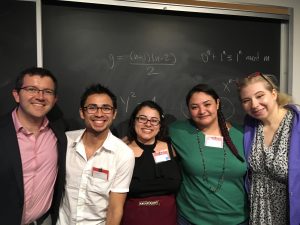
Left to right: Anthony Varilly-Alvarado (Rice University), Pablo Solis (Stanford University), Bianca Thompson (Harvey Mudd), Pamela Harris (Williams College), and Rosemary Guzman (University of Chicago).
- Social Justice! Just as there was a clear commitment to inclusivity in the organization and messaging for the conference, there was also a clear effort to highlight important work in the areas of intersection between mathematics and social justice.
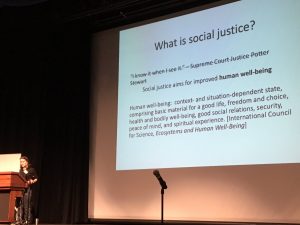
Lily Khadjavi defines social justice.
Lily Khadjavi took us on a mathematical exploration of racial profiling in Los Angeles. I particularly liked the careful approach Khadjavi took to speak of all these issues. Sometimes these ideas get dismissed as not being “rigorous”, but I think Khadjavi showed that there are good ways of thinking of these issues, from finding good definitions to really exploring the existing data. This information and its analysis leads to better and more humane policing practices as a result.
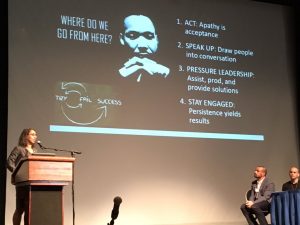
Important recommendations from Talitha Washington.
The panel on STEM disciplines and Higher Ed. highlighted the different paths we can take to mathematics, the different ways we can improve the culture, and Dagan Karp reminded us that all of this is an ongoing process: “We should be constantly engaged in self-examination”.
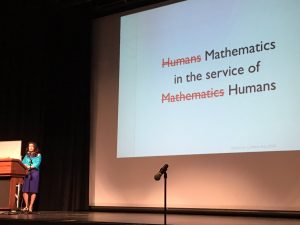
Rochelle Gutierrez talks about ways to “rehumanize” mathematics.
And of course, I cannot talk about this conference without mentioning the incredible Rochelle Gutierrez. From the pop-up session about how to support mathematicians who are doing public scholarship (and who are increasingly under attack by organized social media harassment campaigns), to her beautiful reflection on how to rehumanize mathematics, to her clearly generous nature (she was constantly talking to faculty and students, all of us very eager to get to know her better). The idea of rehumanizing mathematics was particularly powerful: the goal being to allow identity and self in mathematics and as a result
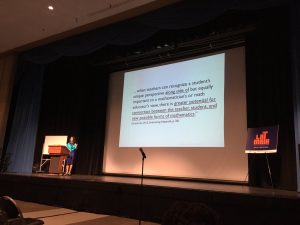 to achieve better inclusion. In a recent conversation, a colleague mentioned that diversity on its own is never the goal. The goal should be equal access to everyone, diversity is just going to be a result of a successful inclusive practice. This used to be the idea of equity, but Gutierrez challenged us to go further: equity is also not the goal (and also very difficult to define) but rather re-humanization of our discipline, and then equity and diversity will follow. In the picture above, she mentions that we should think of mathematics as a way to help humans. By this she does not mean we should all do applied math, in fact math that brings us joy, that fosters creativity, also enhances our humanity (Francis Su made a similar point in this wonderful speech). You also have to hand it to someone who gets a huge room full of people to chant “Whose Math? Our Math!” at the end of a talk.
to achieve better inclusion. In a recent conversation, a colleague mentioned that diversity on its own is never the goal. The goal should be equal access to everyone, diversity is just going to be a result of a successful inclusive practice. This used to be the idea of equity, but Gutierrez challenged us to go further: equity is also not the goal (and also very difficult to define) but rather re-humanization of our discipline, and then equity and diversity will follow. In the picture above, she mentions that we should think of mathematics as a way to help humans. By this she does not mean we should all do applied math, in fact math that brings us joy, that fosters creativity, also enhances our humanity (Francis Su made a similar point in this wonderful speech). You also have to hand it to someone who gets a huge room full of people to chant “Whose Math? Our Math!” at the end of a talk. - People. The best thing about this conference was the people. I had enough time to catch up with friends, colleagues, former students, future colleagues, collaborators, co-conspirators, and yet there were still many I missed or didn’t get to see as much as I would have liked. But I could see it the most in the students, many of them were just so happy to be part of a safe and welcoming community. In fact, I heard a couple of people warn them that not all conferences are this welcoming, positive, and happy. To which I say, maybe it’s time to commit to always being those kinds of conferences.
So, dear readers, what was your favorite moment from the LatMath conference? Please share any thoughts or comments below.
